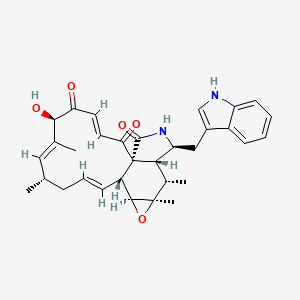| MeSH term | MeSH ID | Detail |
|---|---|---|
| Leukemia, Lymphocytic, Chronic, B-Cell | D015451 | 25 associated lipids |
| Cholangiocarcinoma | D018281 | 7 associated lipids |
Chaetoglobosins
Chaetoglobosins is a lipid of Polyketides (PK) class. The involved functions are known as Drug Interactions, cell motility, Polymerization, Cell Cycle Arrest and Cytokinesis. Chaetoglobosins often locates in host, nucleocapsid location, Microfilaments and Skeletal system. The associated genes with Chaetoglobosins are TP53 gene.
Cross Reference
Introduction
To understand associated biological information of Chaetoglobosins, we collected biological information of abnormalities, associated pathways, cellular/molecular locations, biological functions, related genes/proteins, lipids and common seen animal/experimental models with organized paragraphs from literatures.
What diseases are associated with Chaetoglobosins?
There are no associated biomedical information in the current reference collection.
Possible diseases from mapped MeSH terms on references
We collected disease MeSH terms mapped to the references associated with Chaetoglobosins
PubChem Associated disorders and diseases
What pathways are associated with Chaetoglobosins
There are no associated biomedical information in the current reference collection.
PubChem Biomolecular Interactions and Pathways
Link to PubChem Biomolecular Interactions and PathwaysWhat cellular locations are associated with Chaetoglobosins?
Visualization in cellular structure
Associated locations are in red color. Not associated locations are in black.
Related references are published most in these journals:
| Location | Cross reference | Weighted score | Related literatures |
|---|
What functions are associated with Chaetoglobosins?
Related references are published most in these journals:
| Function | Cross reference | Weighted score | Related literatures |
|---|
What lipids are associated with Chaetoglobosins?
There are no associated biomedical information in the current reference collection.
What genes are associated with Chaetoglobosins?
Related references are published most in these journals:
| Gene | Cross reference | Weighted score | Related literatures |
|---|
What common seen animal models are associated with Chaetoglobosins?
There are no associated biomedical information in the current reference collection.
NCBI Entrez Crosslinks
All references with Chaetoglobosins
Download all related citations| Authors | Title | Published | Journal | PubMed Link |
|---|---|---|---|---|
| Walsh JP et al. | Diagnostic fragmentation filtering for the discovery of new chaetoglobosins and cytochalasins. | 2019 | Rapid Commun. Mass Spectrom. | pmid:30325552 |
| Yang MH et al. | Aureochaeglobosins A-C, Three [4 + 2] Adducts of Chaetoglobosin and Aureonitol Derivatives from Chaetomium globosum. | 2018 | Org. Lett. | pmid:29771535 |
| Hu Y et al. | Gα-cAMP/PKA pathway positively regulates pigmentation, chaetoglobosin A biosynthesis and sexual development in Chaetomium globosum. | 2018 | PLoS ONE | pmid:29652900 |
| Jiang C et al. | Identification and characterization of the major antifungal substance against Fusarium Sporotrichioides from Chaetomium globosum. | 2017 | World J. Microbiol. Biotechnol. | pmid:28466302 |
| Zhao SS et al. | Chaetomium globosum CDW7, a potential biological control strain and its antifungal metabolites. | 2017 | FEMS Microbiol. Lett. | pmid:28011695 |
| Ashrafi S et al. | Ijuhya vitellina sp. nov., a novel source for chaetoglobosin A, is a destructive parasite of the cereal cyst nematode Heterodera filipjevi. | 2017 | PLoS ONE | pmid:28700638 |
| Zhu X et al. | Penochalasin K, a new unusual chaetoglobosin from the mangrove endophytic fungus Penicillium chrysogenum V11 and its effective semi-synthesis. | 2017 | Fitoterapia | pmid:28958956 |
| Jiang T et al. | Overexpression of the Global Regulator LaeA in Chaetomium globosum Leads to the Biosynthesis of Chaetoglobosin Z. | 2016 | J. Nat. Prod. | pmid:27759375 |
| Chen C et al. | Armochaetoglobins A-J: Cytochalasan Alkaloids from Chaetomium globosum TW1-1, a Fungus Derived from the Terrestrial Arthropod Armadillidium vulgare. | 2015 | J. Nat. Prod. | pmid:26068802 |
| Li B et al. | Chaetoglobosin K induces apoptosis and G2 cell cycle arrest through p53-dependent pathway in cisplatin-resistant ovarian cancer cells. | 2015 | Cancer Lett. | pmid:25304379 |
